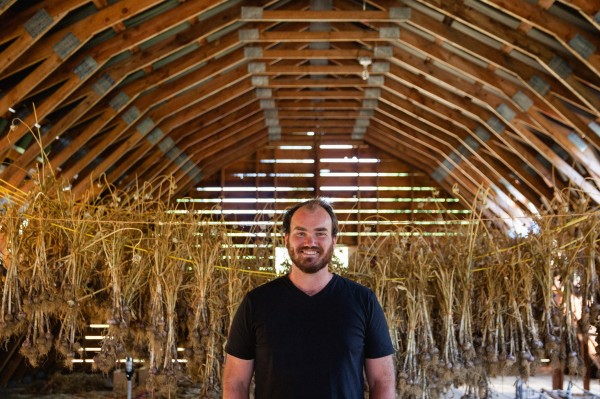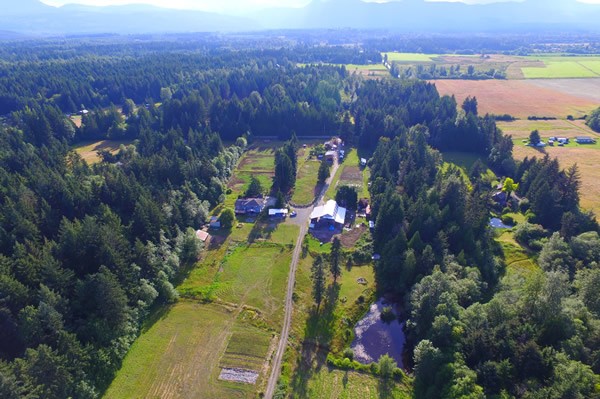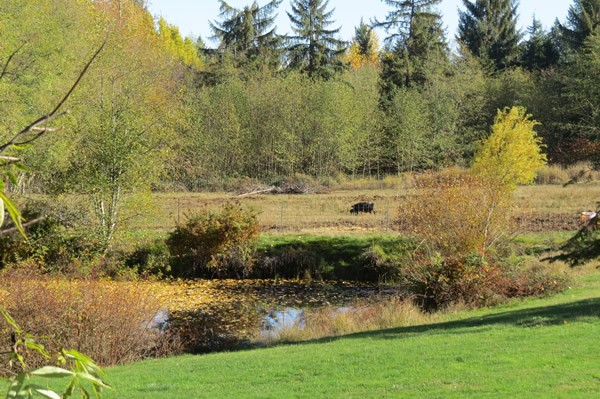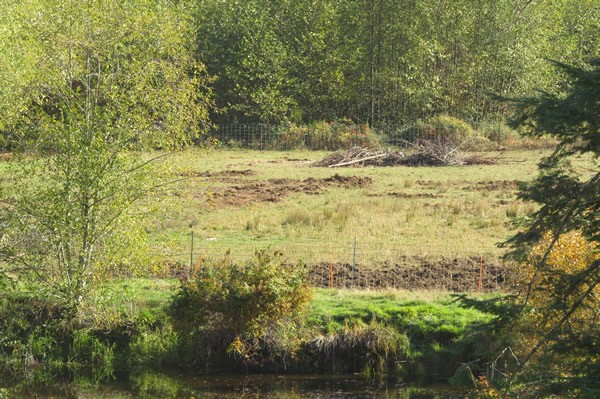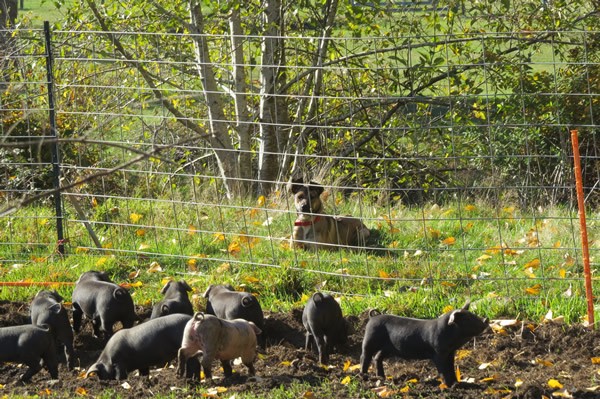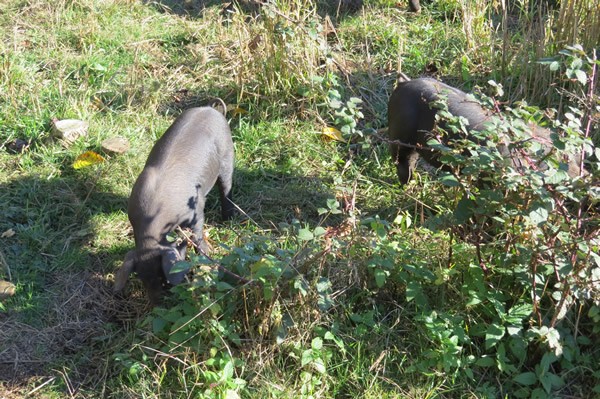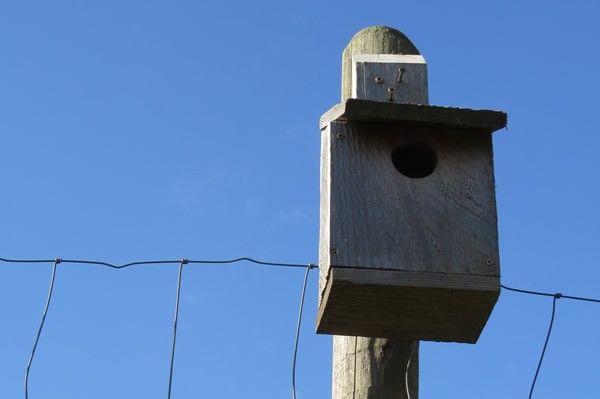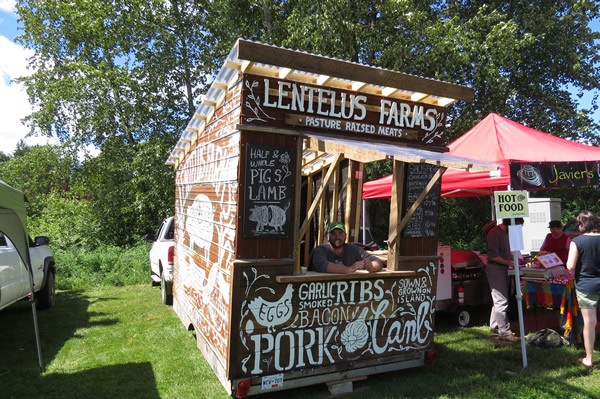Site Description
Name of the site: Lentelus Farms
Address: Vancouver Island | Comox Valley
Size: 28 acres on multiple sites
Type of crops: Mixed agroecological meat and garlic production
Property: Lease multiple farms
Creating biodiverse agroecological systems contribute to a healthy biosphere, which in turn creates healthy, profitable farming conditions.
~Dave Semmelink
Stewardship Practices Guides
The following guides are relevant to this project site
- Riparian Areas in Settled Landscapes
- Guidance for Restoration Activities in Riparian Areas
- Drainage Maintenance in Agricultural Waterways
Click to download the table for stewardship practices at the Lentelus Farm.
Stewardship project partner
Environmental Farm Plan Program
Project Overview
Dave Semmelink’s operation was founded on his philosophy of producing high quality, sustainable and humanely raised meat. His operation spans multiple farms across the Comox region. He aims to control all facets of the operation: growing the herbicide-free grain, raising the livestock, completing the meat processing and selling his product at local markets and restaurants.
He uses a diversity of practices to increase biodiversity on his farms, including the installation of bird boxes and the protection of riparian areas. By partnering with the Environmental Farm Plan program Dave could install cross fencing that allows him to keep his livestock out of the riparian areas. The cross fencing also allows him to rotate his animals. This has many benefits to the soil and animals but it also is good at preventing excess build-up of manure. He rotates his animals and keeps them on high and dry areas in winter so that manure doesn’t runoff.
Much of the land Dave farms on was previously abandoned. The land is often overrun with invasive and pioneer plant species. His animals are extremely effective at clearing these areas. First, he sends in the sheep to clear new growth. The pigs go in next and root up stumps and blackberry roots. The sheep are returned to eat all the greens to prevent regrowth. He commonly deals with thistle, reed-canary grass, blackberry, and scotch-broom. He sometimes also gives his animals a hand and does some mowing to prevent invasive plants from coming back up.
Key Stewardship Practices:
- Protect plantings from wildlife and livestock
- Avoid manure over application
- Control invasive species
Champion
Dave Semmelink
Motivation
Dave was born in South Africa, where much of his time was spent on farms throughout the Western Cape. Many of these farms contained large nature reserves and it is here he gained a deep appreciation for nature. Much of his time on these farms was devoted to outdoor activities. He explains that these experiences shaped how he views the important role agriculture plays in supporting biodiversity:
I was born and raised in a small agricultural community in South Africa. I spent a lot of time on farms, most of which had set aside non-productive land for habitat. I would often go fishing and hiking. I was really lucky to spend all this time in nature. I think this is part of why I think agriculture is so important in sustaining wildlife habitat.
Since immigrating to Canada more than a decade ago, Dave studied Natural Resources Conservation at the University of British Columbia (UBC), majoring in management science, and worked as crew boss supervising the planting of millions of trees across B.C.. These experiences drew him further to sustainable agriculture.
I really enjoyed my time tree-planting in these wild places all over British Columbia. At the same time, I was studying conservation at UBC which really drove home that as a society we need to start looking after our environment better. I decided that the best route to protect, educate and conserve nature, was to start a farm demonstrating how one can create a profitable business and maintain a healthy environment.
Challenges
Dave’s major challenges to implementing stewardship practices are time and resources. As a young farmer that leases land and works part time this can be particularly challenging when other more immediate tasks need to be completed.
Finding the time, resources and energy to work on non-essential environmental improvements is challenging. One needs to be creative to find solutions.
One of his solutions to having little time to work on stewardship projects is to find help. He’s been able to recruit volunteers from the University of British Columbia’s conservation management school to work on projects like the building of bird boxes.
Building bird boxes is such a challenge that was overcome with a group of volunteers from UBC’s Conservation management field school program that came out to the farm and built bird boxes to put up around one of his leased farms.
Finding resources, particularly funding he says is harder. But he has still managed to receive funding from the Environmental Farm Plan program. This removed the financial barrier to getting fencing which allowed him to keep his livestock out of the riparian areas and rotate them to avoid the accumulation and runoff of manure. Even with programs that provide funding, he still sometimes struggles as some programs require you to first pay and then get reimbursed.
Fronting capital for things like riparian fencing is hard when you aren’t working with huge lines of credit, the EFP does a great job of partnering with farmers to use best management practices, although it does require you to pay for the project up front and will only pay their portion after the project is completed.
Outcomes
Dave enjoys spending time on his farm because of all the wildlife that he can enjoy without leaving the property. On the one farm he leases, he describes the many different animal species he has seen.
Farms can be biodiverse habitats for animals. On this farm, we have rough skinned newts, a resident blue heron in the pond, and many different types of ducks. We get black bear visits occasionally, many black tail deer, I’ve even found cougar scat. We also have lots of birds including some tree swallows which live in the nest boxes we built, and a nest of bald eagles. The riparian habitat also seems to draw birds like a magnet.
Dave describes stewardship as a win-win situation, reasoning that a healthy environment leads to a profitable business. He uses the example of preventing livestock entering riparian areas to maintain water quality:
Animals can have a large impact on a small fragile riparian area. They can foul up water sources and make it less appealing for me to use water. Creating biodiverse agroecological systems contribute to a healthy biosphere, which in turn creates healthy, profitable farming conditions.
For agricultural producers interested in adopting stewardship practices, Dave recommends starting with an Environmental Farm Plan, as it can provide you with the resources to complete a project. He thinks that once a producer starts doing these types of projects, the benefits will motivate further adoption of stewardship practices.
Once you have one project done, you’ll see the benefits in terms of wildlife and biodiversity and then you’ll just want to do more.
Stewardship Practices Menu
Learn more about Species at Risk
Stewardship Practices Case Studies
Fraser Valley & Lower Mainland Sites
Kootenay Sites
Okanagan Sites
Vancouver Island Sites
Contact Information
Find us on social media
LinkedIn: @StewardshipCentreBC YouTube: @stewardshipcentreforbc1047 Instagram: @StewardshipBC

